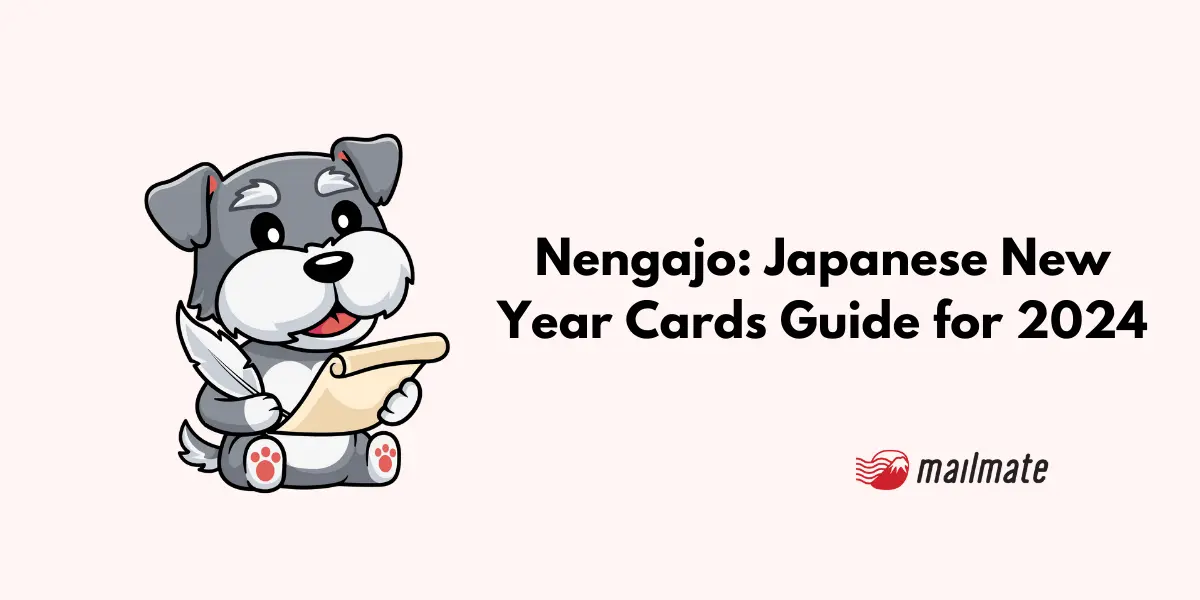Nengajo: Japanese New Year Cards Guide

The number of New Year's postcards 年賀状 = nengajo issued in 2021 clocked in at approx. 1.83 billion pieces.
These cards go on sale yearly from November 1, and post offices begin collections on December 15 to achieve a January 1st delivery.
Photography studios, stationery stores, and even your local Lawson or 7-11 will have dedicated sections presenting New Year's postcards 年賀状 or nengajo.
So just what do you need to know about Japan's year-end greeting traditions?
Are your Japanese friends expecting you to send these? Will you get side-eye if you don't? And what should you do if you're the recipient of a New Year's postcard?
Here's everything you need to know (and a little bit extra) about Japan's New Year's greetings.
What is a nengajo in Japanese?
Nengajo or 年賀状 are New Year's cards in Japan. It’s similar to sending Christmas cards to family and friends; however, Japanese people send nengajo to friends and family, coworkers and business associates, customers and clients for seasonal greetings and well wishes.
Why are nengajo important?
Nengajo is important in Japanese culture as it stems from traditional and old customers sending well wishes for the coming year. Even today, nengajo is important as it symbolizes friendship, family, and positive connections.
The history of Japanese New Year Cards—nengajo
According to Japan's online museum dedicated to New Year greeting cards, Japan's first New Year's greetings were exchanged not too long after the adoption of the Chinese calendar by the Yamato court at the beginning of the 7th century.
While there is no historical record of who sent the first New Year's greetings in Japan, a collection of letters by Fujiwara no Akihira contains examples of New Year's greetings, suggesting they had become widespread among the elite during the late Heian period (794–1185).
With the establishment of the Gokaido under Tokugawa Iyesu's rule and the explosive rise of merchant culture, letters were exchanged not only among the upper class but also among the working class.
A reference to New Year's greeting cards in a 1702 poem further shows they had become a standard greeting during the Edo period (1603–1867).
Nengajo and Japan’s postal system
When the Meiji government established Japan’s postal system in 1871, New Year's greetings were inside envelopes. But when the postcard medium was created, citizens quickly switched to sending New Year greetings via postcard from as early as 1875.
![[Image: A nengajyou postcard from 1877. Nengajyou Hakubutsukan.]](http://images.ctfassets.net/rrofptqvevic/5NOU1r0U0ckRWTyYhkQFLb/f3964cff3e2dd7830a7dabc9806c6693/nengajyou_postcard_from_1877-min.webp)
A nengajyou postcard from 1877 | Nengajyou Hakubutsukan
Due to the sheer volume of New Year's greetings, it has caused annual postal delays, as those sending these postcards want them to be postmarked on the first day of the New Year and in time for a new year's day delivery. Therefore, there would be a rush to the post offices in the week immediately before January 1.
Various systems were experimented with to ease the year-end postal burden. Finally, in 1899, a special countermeasure was legislated. If you brought your New Year greeting card to the post office between December 20 and 30, it would be postmarked on January 1 and delivered in the New Year (early January, but not necessarily on New Year's Day).
The number of post offices designated for special handling of New Year's greeting cards gradually increased, and by 1905, all post offices in Japan could handle this service. In 1907, new legislation allowed postcards to be dropped in mail collection boxes as long as they were marked "New Year's greetings" on the front—the current system we use today.
Japan New Year’s postcard lottery お年玉付き年賀
The lottery-postcard system started in 1949 (Showa 24), when Masaji Hayashi, a private citizen, proposed attaching a lottery number to each New Year greeting card sold by the post office.
Essentially, he felt that people might stop sending cards to each other (this was right after World War II) and that attaching a raffle number to each postcard would encourage people to inquire after friends and help lift the spirit of a depressed nation.
The ministry decided, why not? The prizes included a sewing machine, wool fabric, gloves for school-aged children, an umbrella for school-aged children, etc.
![[Image: Poster advertising the first New Year’s postcard lottery from 1949. Postal Museum Japan.]](http://images.ctfassets.net/rrofptqvevic/6Pept7EBCki01q21mmd8Xl/c412ef31c5a12eab37ff2d29af310c05/first_New_Year_s_postcard_lottery_from_1949-min.webp)
Poster advertising the first New Year’s postcard lottery from 1949 | Postal Museum Japan
The New Year postcard lottery became an instant hit. The volume of New Year's cards increased significantly that year and rose with each subsequent year until 2003.
Today, the New Year’s postcard lottery is still in place; last year, the lottery drawing was held from January 18th. The full list of prizes can be found on Japan Post’s site.
Who should I send nengajo to?
Many Japanese people use nengajo to stay in touch with relatives, friends, and acquaintances. It is also acceptable to send greetings to coworkers, one’s boss, and business partners.
However, sending New Year’s greetings has been on the decline. In 2003, the number of New Year's cards issued reached a high of 4,459,360,000, but by 2020, the number had dropped to 1,941,980,000.
Similarly, the number of New Year's cards per person peaked in 2003 at 35 per person. But since then, the number of cards per person has gradually decreased, reaching a record low of 16 cards per person in 2021.
Still, a survey of 1,200 people conducted in 2021 revealed that over half planned to send New Year’s greeting cards. And more than 60% of those surveyed had sent greetings the year before.
It varies from person to person to whom you want to send nengajo. As a foreigner, it’s doubtful you’ll hurt any of your relationships if you don’t send them out. But a rising number of Japanese would prefer not to partake in this tradition. At the time, though, some people were letter-writing-greeting-card-type. While others aren’t.
The bottom line is if you don’t want to, you don’t have to.
How do I write a nengajo address?
Here’s an example from Dekiru.net on addressing a New Year’s greeting card.
![[Image: Dekiru.net]](http://images.ctfassets.net/rrofptqvevic/2NUpt9TT5NN1acl7HDVTRw/458161fe034efa66e70d1b9ae00b859a/How_to_write_the_address_on_a_New_Year_card-min.webp)
How to write the address on a New Year card from Dekiru.net [Translated]
Pay Attention To Spacing: There should 1-character gap space between the zip code and the right edge of the postcard. Write the full address, including the prefecture, and use Chinese numerals when writing vertically and digits when writing horizontally.
The Name of the Apartment Building: Have it written slightly smaller and lower than the first address line.
Receipt’s Name: The name should be written slightly larger than the address and include a space between each character to maintain a pleasing balance.
Japanese honorifics: Include “sama” 「様」below the name. If the letter is addressed to a mentor, doctor, lawyer, or politician, add "Sensei” 「先生」.
年賀: If you are sending a “normal” postcard (not one specifically sold as a New Year postcard), write "Nenga" 「年賀」in red below the stamp.
Your Return Address/Sender Info: Stay within the width of the stamp. (It is also acceptable to write your address on the back of the card.)
👉 Use our Japan Postal Codes tool to help you find the postal codes for places throughout Japan!
If you want to see a Japanese calligrapher write the address for a nengajo, watch the following video.
What do you say in a New Year (nengajo) greeting card? What message should I include?
Japan’s NewYears’ greeting cards all follow a typical structure. Here’s an example provided by Japan Post:
![[Image: Japan Post.]](http://images.ctfassets.net/rrofptqvevic/5TNNH7HfFcGDXmn3miIpUw/624178d9b49e1b0c2d248c83735722dc/image_-_2023-07-20T152802.285.webp)
Standard format of a nengajo by Japan Post
A New Year's card generally consists of the following items in order.
A New Year greeting, such as 「謹賀新年」「賀春」are often written in a larger size than the rest of the text.
Next, you write a sentence that expresses gratitude for the previous year's relationship, joy at having successfully arrived at the New Year, and other sentences that express thankfulness.
The body of the letter includes recent developments, aspirations, thoughts, and apologies.
You conclude with wishes and expectations for the recipient's health, happiness, prosperity, and success
Although there is some variation depending on degrees of closeness, this is the general structure of a New Year’s greeting card, and you can’t go wrong if you follow this outline.
Where can I buy nengajo (Japanese New Year cards)?
You can buy nengajo at any department shop, convenience store, online, or at your local post office. They are sold singly or in bulk. The price is 63 yen per card, which includes the price of postage.
If you want to purchase nengajo online, here are links for searching for them on Rakuten, Amazon Japan, and Yahoo Shopping. (Keep in mind that nengajo are pricier online than if you were to buy them in person at the Post Office or your local convenience store.)
You can also make a Japanese New Year card from scratch by cutting down a blank card into the appropriate size, etc.
Frequently asked questions
What are some standard greetings I can use in a nengajo?
Here’s a standard greeting that you can use with anyone, as suggested by futabanenga.jp:
昨年は色々とお世話になりありがとうございました本年もどうぞよろしくお願いいたします
Approximate translation: “Thank you for all your help last year. I look forward to working with you again this year!”
If you want to wish someone a happy new year simply, you would say あけまして おめでとう ございます (akemashite omedetou gozaimasu).
When do I need to send nengajo (Japanese New Year cards) out by?
The postal collection of Japanese New Year's greeting cards begins on December 15. If you want your New Year's greeting delivered on January 1, make sure you have sent it in by December 25. You can reply to New Year's greetings from January 1 to January 7.
Take note: From January 8 onwards, it will become a winter greeting and not a New Year greeting.
What is the standard size of a nengajo?
The standard size of a nengajo is 10.0cm width × 14.8cm tall. It weighs 3.1 grams. In inches, a nengajo is 3.94 inch width × 5.83 inch tall.
Can I send nengajo (Japanese New Year cards) for free?
You can send free nengajo via online apps, such as LINE. However, “free” digital nengajo do not have a postal lottery number attached. The advantages to sending a free digital nengajo include little-to-no prep work required and not needing to know the other person's postal address to send a New Year's greeting.
Why are New Year’s cards sent in Japan?
New Year’s cards are sent in Japan as a means of showing gratitude to those who have helped you in the past year. Additionally, individuals also use this opportunity to contact and connect with those they haven’t been in touch with, whether relatives, friends, or business acquaintances.
Final thoughts
As a foreigner in Japan, it’s unlikely anyone will expect you to send nengajo. But if you have an acquaintance, co-worker, or friend who has been particularly supportive, sending a New Year greeting is a great way to show appreciation.
Related articles on Japan’s postal system
Japan Post Forwarding: How to Forward Mail Online [With Pictures]
What Is a Virtual Mailbox Service in Japan? [Your FAQs Answered!]
International Shipping from Japan: Options & FAQs [Updated 2022]
Spending too long figuring out your Japanese mail?
Virtual mail + translation services start at 3800 per month. 30-day money-back guarantee.

